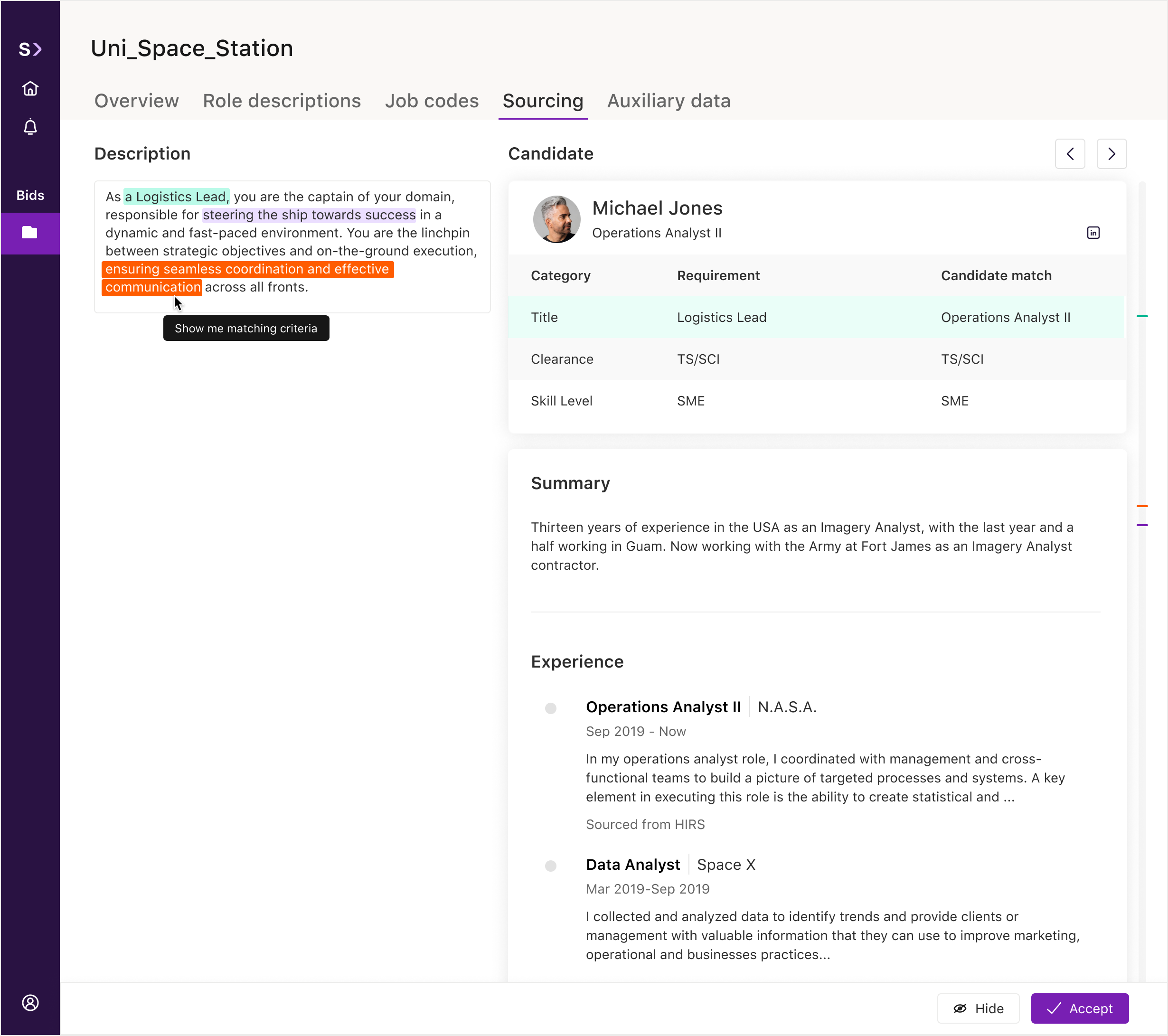
Using AI to help governments expedite their staffing plans.
Design Lead
About SeekOut
SeekOut's product is the leader in AI recruiting and talent strategy development. As part of the GROW team, I worked with leadership to conceptualize, validate, and deliver a new product through the definition and MVP phases.
The Problem
Talent staffing at the government level is hectic because projects are defined in parallel with multiple external recruiting companies. These companies have to win a project by bidding against one another. This process is highly inefficient and time-consuming.
Furthermore, most of these projects run on tight deadlines, creating a stressful environment that can cost millions of dollars without guaranteeing a successful bid.
The Solution
Create an experience that supports teams at every step of the bidding process by taking their workflow from hundreds of worksheets into one place, adding a layer of AI to help define, find, and write key pieces of the staffing requirements to save hundreds of hours of work.
Discovery
I began researching the current process by:
Reading the government documentation on the matter on websites such as FEDSIM.
Listened to hours of Gong recorded conversations with government recruiting contractors.
Talking to customers in the A&D space to learn about their pain points when working with the government.
I worked with a small team of one back-end engineer, one front-end engineer, and one Principal Project Manager.
Every Monday, I’d run co-creation sessions. The goal was to discuss all my learnings and co-create pieces of the system.
Initial Takeaways
Collaboration is key
There can be anywhere between 10 to 30 people which will impact the project outcome.
Outdated workflow
The people working on these projects will create hundreds of Excel files to share with multiple teams.
Messy Data
Finding the right information to update during the review process is time-consuming and prone to human error.
Challenges
Validating assumptions
Companies start bid planning a year before the government releases the final staffing plan. Having a pre-defined plan based on historical information is key to winning.
Disconnected information
A team will review multiple workbooks to gather information to validate a single qualified candidate for a role out of hundreds.
Lack of support
Small changes can have a huge impact on staffing plans. Currently, there is no record to help outline how wide these changes can influence progress.
Core Experience
Solutions
Schemas
As a project matures, new information is shared with recruiting companies to help refine roles. I created a self-served schema builder so users can introduce this new information to their staffing plan to reinforce candidate qualifications.
Clean the data
Job codes are unique to a role. However, projects can have multiple roles with similar criteria and be matched with different candidates. Allowing users to link unique codes to a single role can help avoid double staffing per role.
Generate role descriptions
Composing role descriptions is a collaborative effort. Before SeekOut, teams had to gather specific information from multiple worksheets. With AI, we can generate descriptions as a starting point and allow users to modify them to best fit their needs.
Approve candidates
The last step is selecting candidates for each role. When job codes, role descriptions, and schemas work together, we can present candidates who match the criteria. Furthermore, we can suggest the best qualifications substitutions for the role for a wider range of options.
Impact
The total number of hours working on a bid during the first 2 weeks was reduced by 40%.
The quality of role descriptions created was of higher quality and comprehension.
Instant user adoption increased interest in the rest of SeekOut’s business offerings.
Next Steps
The MVP allowed us to move fast and wide. After our initial offering was validated we had a chance to go deep in our design progressions that were conceptualized along as we learned from our conversations with clients.











